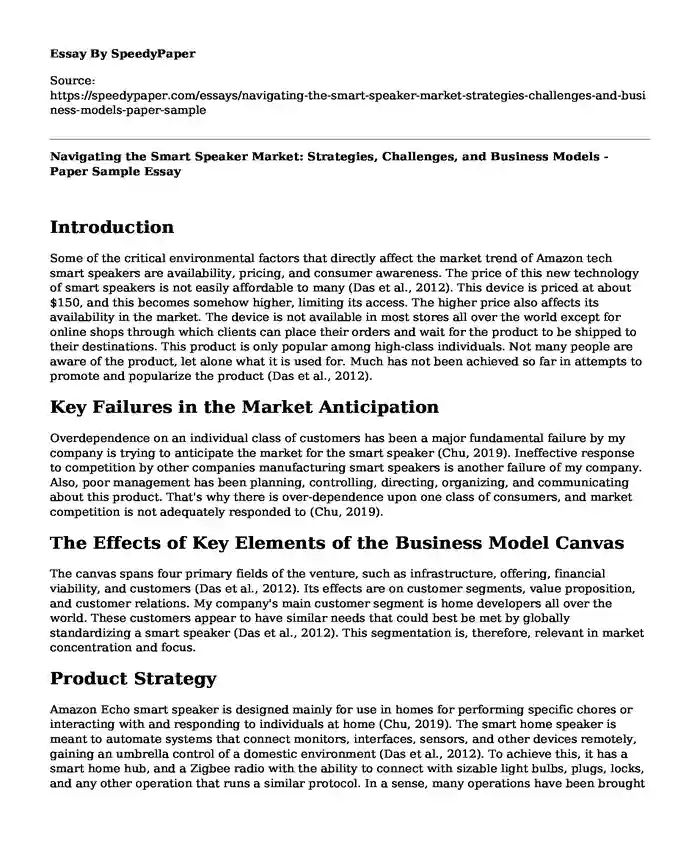
| Type of paper: | Essay |
| Categories: | Company Business Strategic marketing |
| Pages: | 3 |
| Wordcount: | 692 words |
Introduction
Some of the critical environmental factors that directly affect the market trend of Amazon tech smart speakers are availability, pricing, and consumer awareness. The price of this new technology of smart speakers is not easily affordable to many (Das et al., 2012). This device is priced at about $150, and this becomes somehow higher, limiting its access. The higher price also affects its availability in the market. The device is not available in most stores all over the world except for online shops through which clients can place their orders and wait for the product to be shipped to their destinations. This product is only popular among high-class individuals. Not many people are aware of the product, let alone what it is used for. Much has not been achieved so far in attempts to promote and popularize the product (Das et al., 2012).
Key Failures in the Market Anticipation
Overdependence on an individual class of customers has been a major fundamental failure by my company is trying to anticipate the market for the smart speaker (Chu, 2019). Ineffective response to competition by other companies manufacturing smart speakers is another failure of my company. Also, poor management has been planning, controlling, directing, organizing, and communicating about this product. That's why there is over-dependence upon one class of consumers, and market competition is not adequately responded to (Chu, 2019).
The Effects of Key Elements of the Business Model Canvas
The canvas spans four primary fields of the venture, such as infrastructure, offering, financial viability, and customers (Das et al., 2012). Its effects are on customer segments, value proposition, and customer relations. My company's main customer segment is home developers all over the world. These customers appear to have similar needs that could best be met by globally standardizing a smart speaker (Das et al., 2012). This segmentation is, therefore, relevant in market concentration and focus.
Product Strategy
Amazon Echo smart speaker is designed mainly for use in homes for performing specific chores or interacting with and responding to individuals at home (Chu, 2019). The smart home speaker is meant to automate systems that connect monitors, interfaces, sensors, and other devices remotely, gaining an umbrella control of a domestic environment (Das et al., 2012). To achieve this, it has a smart home hub, and a Zigbee radio with the ability to connect with sizable light bulbs, plugs, locks, and any other operation that runs a similar protocol. In a sense, many operations have been brought under one control in the smart home scheme. Its ability to assist in the control and partial replacement of bulbs is another outstanding additional feature.
Positioning Strategy
This is the ability to influence the perception of the consumers concerning a product that has competition in the market (Keane et al., 2018). It determines to build a strong image of the brand. The products that have been manufactured by Amazon have a superior position in the world market based on the brand. The company logo is attractive and easy to stitch in the minds of many consumers. The additional applications attached to the Amazon Echo smart speaker, such as the smart home hub allowing for application conglomeration, position the product better than those from other competitors (Chu, 2019).
Market Strategy
This is the overall game plan of a business in reaching out to prospective customers and winning over to your products instead of the others offered by competitors (Varadarajan, 2015). The goal is to sell more to many people in the world's target market. This strategy is achievable through attractive pricing, promotions, and branding (Varadarajan, 2015).
References
Chu, L. (2019). Why would I adopt a smart speaker?: Consumers' intention to adopt smart speakers in a smart home environment (Master's thesis, University of Twente).
Das, B., Cook, D. J., Schmitter-Edgecombe, M., & Seelye, A. M. (2012). PUCK: an automated prompting system for smart environments: toward achieving automated prompting—challenges involved. Personal and ubiquitous computing, 16(7), 859-873.
Keane, S. F., Cormican, K. T., & Sheahan, J. N. (2018). Comparing how entrepreneurs and managers represent the elements of the business model canvas. Journal of Business Venturing Insights, 9, 65-74.
Varadarajan, R. (2015). Strategic marketing, marketing strategy, and market strategy. AMS Review, 5(3-4), 78-90.
Cite this page
Navigating the Smart Speaker Market: Strategies, Challenges, and Business Models - Paper Sample. (2023, Dec 20). Retrieved from https://speedypaper.com/essays/navigating-the-smart-speaker-market-strategies-challenges-and-business-models-paper-sample
Request Removal
If you are the original author of this essay and no longer wish to have it published on the SpeedyPaper website, please click below to request its removal:
- Free Essay Sample: Ethics and Business
- Free Essay Example. Hopfenreich Brand Analysis
- Essay Sample on Supply and Demand in American Auto Industry
- Essay Example on Social Media Strategies: Personal Branding
- M&M's: Competing in the US Chocolate Market - Essay Sample
- Globalization in the Field of Doing Business. Paper Example
- Coca-Cola and Corporate Social Responsibility - Free Essay Sample
Popular categories




